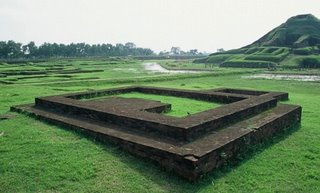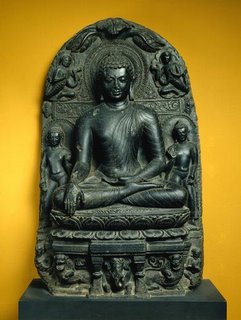Gopala

After Sasanka, the principalities that make up modern-day Bengal -- Goura, Pundra, Rarha, Barendra, Samatata, Banga, as well as Sasanka's feudatories in Magadha, Anga, Kalinga, Odra -- were shattered by repeated invasions and slid into a 100 year obscurity. The Tibetan warlord Songtsan Gampo (622-650 CE) invaded and conquered Barendra. Jayavardhana of the Shaila Dynasty from Central India marauded through and killed the king of Pundra (730 CE). Yasovarmana (725-752) of Kanauj killed the king of Magadha and Goura. Lalitaditya (724-760) of Kashmir who defeated Yasovarmana also invaded Bengal in turn. Sri Harsha of Kamarupa ransacked Anga, Banga, Kalinga, Odra. The social and political structure of Bengal was in ruin. According to Lama Taranath in his history of Buddhism in India, in that time 'all across Odra, Banga and the other five eastern provinces every single Kshatriya, every Vaishya and every Brahmin of consequence proclaimed himself to be a local king, but there was no overall monarch capable of uniting these squabbling feudals.' A number of contemporary sources borrowed the world 'matsyanyaya' or 'law of fishes' (i.e. big ones eating the smaller ones) from Chanakya to describe the prevalent situation. Chanakya had said:
अप्रणीतो हि मात्स्यन्यायमुद्भावयति वलीयानवलं हि ग्रसते दंडधराभावे
Apranito hi matsyanyayamudhbhavabayati baliyanbalam hi grasate dandarabhave
Matsyanyaya comes into being if the royal sceptre (danda) remains unapplied. In the absence of a dandadhara (wielder of the sceptre) the strong swallow the weak.
In this situation, in a fine example of democracy in a hot climate, the people of Bengal elected a certain Gopala to be the leader of Goura, Banga, Magadha et al. This took place sometime around 750. Gopala was the founder of the great Buddhist Pala dynasty, which at its zenith under his son Dharmapala had conquered all of North and Central India from 'Kedarnath (in the Himalayas) to Gokarna (in Goa),' and extracted obedience from the kings of 'Bhoj, Matsya (current MP and Rajasthan), Kuru, Yadu (Punjab and Western UP), Panchala (central UP), Avanti (Ujjain and Malwa), Gandhara(Afghanistan), Yavana (the region of NWFP held by Huns and Turkico-Persian tribes) and Kir (Kangra in HP.)' Certainly Gopala seems to have been an aggressive warrior (albeit with a nice Buddhist touch):
His uncountable armies set into motion for war, their feet kicked up such dust that the sun was obscured and the birds could walk about in densely dusty skies rather than having to fly. Upon conquering all his enemies till the farthest ocean coast, he felt no more need for conflict and released his blood-maddened war-elephants to freedom in the forests; they, after a while, returned to meet their human friends with tears of joy running from their elephant-eyes.
Those loath to admit Bengalis as a martial race point out that previous invaders of Bengal now counter-attacked by the turning worm were themselves in decline, and that the hollowness of the Palas' military victories was proven when much of their western conquests were lost, within a few generations, to the Gujjars moving in from Central Asia, and to the Pratiharas under King Bhoj; but the two repeated expensive and successful forays into Uttarapath overlordship -- first by Sasanka in the 7th century and then by Dharmapala in the 9th -- points if not to military prowess, then at least to the agricultural surplus that could be generated by 'Sonar Bangla.'
Gopala's origins are somewhat obscure. Certainly the court poets of the Palas do not boast of the lineage of their patrons, which leads to the suspicion that there was not much to boast of. We read Gopala's father Bapyat was a student of the science of war, and his grandfather, a certain Dayitvishnu, was a 'sarva-vidya-vit' or polymath.
From Wikipedia:
According to Taranatha, Gopala was born of a Kshatriya family near Pundravardhan (north Bengal) and was later selected a ruler of Bangala (Vangala). But some of the historical writings of this period claim that Palas belonged to Shudra caste. Some later writings even claim the Palas were Kayasthas as some of the Pala descendents claimed to belong to the sub-caste. Ramachrita of Sandhyakar Nandi, a court poet of later Palas, states that the Pala dynasty belonged to Samudrakula or Ocean lineage. It is not clear what this really means. Probably, this holds a clue that the ancestors of the Palas belonged to a shipping community of kshatriya cum-trading group who conducted trade via sea with other nations. This may allude to their probable links with the northwest Kambojas who are also attested to have been both a Kshatriyas as well as traders class (varatta-shastropajivins).The Kamauli Grant of king Vaidyadeva of Kamarupa (Assam) connects the Palas to 'Surya lineage' (Mihirasya vamsa).This may again imply their probable connections with the ancient Kambojas who were indisputably Sun/Fire worshipping Iranians.
Haribhadra, a contemporary of Gopala's son Dharmapala mentioned in his Ashtasahasrika Prajnaparamita that the Palas ‘fell from the line of Rajbhatta (Rajbhatta-Vamsa-Patit).’ Rajbhatta can mean Royal Bard, or Royal Servant, and there is also a historical Rajbhatta, who was the son of Devakhadga of the Khadga Dynasty that ruled Banga in the 7th century. Sandhyakar Nandi further states that Barendra or North Bengal was the fatherland (Janakabhu) of the Palas. In a copperplate inscription it has been described that Mahipala recovered his fatherland (Rajyam Pitram) from his enemies -- apparently North Bengal occupied by the Kambojas. Another story in the bard Ghanaram's Dharmamangal describes the Palas being planted out of wedlock in the womb of a princess by the Ocean.
It seems plausible, to echo the treatment of scholars like Rakhaldas Bandyopadhyay, that Gopala originated from Banga (East Bengal) -- deep enough from the deltaic area to qualify as being of Ocean-lineage, obscure enough for even the most enterprising bard not to be able to shed much light on his historical lineage, and that his descendants later settled in Barendra (North Bengal).
However, according to Sir Jadunath Sarkar, Rajbhatta was also the name of a tribal people of ancient India, who lived in the swathe between Gorakhpur and Bundelkhand. The Cheros, who ruled for example in Palamau in Jharkhand till the 17th century, are a branch of the Rajbhattas. There are still many Chero landlords in Palamau, and they consider themselves to be Rajputs, and have surnames like Sisodia. If, indeed, a Bais Rajput tribal soldier from Ayodhya's Baiswara could establish a landlordship in Bengal, convert to Islam, and later rule as Isa Khan, is it so farfetched to think of another wandering charismatic Rajput lord inserting his genes in the coastal Bengal pool of ocean-faring, Indo-China-facing naval chieftains, out of which several generations later arose a great Buddhist warrior, elected into kingship?
In a copperplate inscription from the reign of Dharmapala found in Khalimpur we read: 'In order to banish the Law of Fishes, the Natures (Prakriti-punj) gave to [Gopala] the hand of the Kingdom-goddess Lakshmi. He whose great deeds can only be imitated in lustre by the white light of the full moon, that leader of men and the great diamant gem of his clan, Gopala was born of Bapyat.'
The reference to 'Nature' giving Gopala the kingship is interesting. In the Arthashastra, Chanakya says:
स्व्यम्यनात्य जनपद दुर्ग कोष दण्ड मित्रानि प्रकृत्या
Swamyanatya janapad durga kosh danda mitrani prakritya
i.e. Nature is consisted of the ministers and the friendly officials in charge of the administration of countryside forts, fortified towns, treasury and the army.
In other words, when Matsyanyaya prevented the peoples from organizing a general election on the basis of adult franchise, the mandarins from the official corps could be considered a representation of the nature or essence of the people.
In other words, Gopala may not have been elected in a modern sense, but selected by his peers -- other feudals.
Under the patronage of the Palas, Mahayana Buddhism rose to greatness in Bengal. The Universities of Nalanda, Vikramashila, and Paharpura (pictured above) flourished again after Sasanka's Brahminical counter-reformation. It was through the Pala missionaries that Buddhism was finally established in Tibet. The celebrated Buddhist monk Atisa Dipamkara Srijnana (981-1054) of Vajrajogini in Banga, who reformed Tibetan Buddhism, was the head abbott of the Vikramashila monastery. The Palas maintained relations with the Hindu-Buddhist state of the Shailendras of Sumatra and Java. Also under Pala patronage arose a distinctive school of art, an example of which is shown below.
















